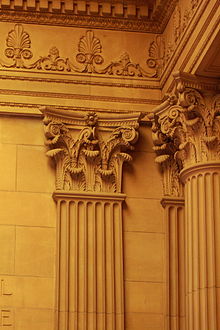Pilaster
In classical architecture, a pilaster is a rectangular support that resembles a flat column. It includes the usual features of a classical column; a capital at the top, the shaft of the column itself, a base and a plinth, but it usually only projects a third of its width or less from the wall.
Pilasters are traditionally used for decorative rather than structural purposes, often as a means of breaking up an otherwise empty expanse of wall. As with columns, different classical orders can be represented, and the surface of a pilaster can be left plain or can be fluted.
The term ‘canton’ refers to a pilaster that appears at the corner intersection of two walls.
Roman architecture made common use of pilasters, as did Renaissance Europe where they became popular on both interior and exterior walls, and as a feature of the Greek Revival style.
NB Short Guide, Scottish traditional shopfronts, published, on 18 April 2017 by Historic Environment Scotland, suggests that a pilaster is : ‘A column, shaft and base which projects slightly from the wall but is generally not structural in nature. Used for shopfront design particularly from the 1850s onwards. May be decorated or plain, often with fluting or reeding.’
[edit] Related articles on Designing Buildings
- Anta.
- Arcade.
- Architrave.
- Barrel vault.
- Bas-relief.
- Classical orders in architecture.
- Colonnade.
- Corbel.
- Cornice.
- Cornice coving and architrave definitions.
- Crocket.
- Elements of classical columns.
- Entablature.
- Fillet.
- Fluting.
- Frieze.
- Italian Renaissance revival style.
- Moulding.
- Pedestal.
- Pediment.
- Soffit.
- Trompe l’oeil.
Featured articles and news
The UK's Modern Industrial Strategy: A 10 year plan
Previous consultation criticism, current key elements and general support with some persisting reservations.
Building Safety Regulator reforms
New roles, new staff and a new fast track service pave the way for a single construction regulator.
Architectural Technologist CPDs and Communications
CIAT CPD… and how you can do it!
Cooling centres and cool spaces
Managing extreme heat in cities by directing the public to places for heat stress relief and water sources.
Winter gardens: A brief history and warm variations
Extending the season with glass in different forms and terms.
Restoring Great Yarmouth's Winter Gardens
Transforming one of the least sustainable constructions imaginable.
Construction Skills Mission Board launch sector drive
Newly formed government and industry collaboration set strategy for recruiting an additional 100,000 construction workers a year.
New Architects Code comes into effect in September 2025
ARB Architects Code of Conduct and Practice available with ongoing consultation regarding guidance.
Welsh Skills Body (Medr) launches ambitious plan
The new skills body brings together funding and regulation of tertiary education and research for the devolved nation.
Paul Gandy FCIOB announced as next CIOB President
Former Tilbury Douglas CEO takes helm.
UK Infrastructure: A 10 Year Strategy. In brief with reactions
With the National Infrastructure and Service Transformation Authority (NISTA).
Ebenezer Howard: inventor of the garden city. Book review.
The Grenfell Tower fire, eight years on
A time to pause and reflect as Dubai tower block fire reported just before anniversary.
Airtightness Topic Guide BSRIA TG 27/2025
Explaining the basics of airtightness, what it is, why it's important, when it's required and how it's carried out.
Construction contract awards hit lowest point of 2025
Plummeting for second consecutive month, intensifying concerns for housing and infrastructure goals.
Understanding Mental Health in the Built Environment 2025
Examining the state of mental health in construction, shedding light on levels of stress, anxiety and depression.






















